President’s 2017 Report to the University Senate
September 22, 2017
This year, Rutgers awarded more than 17,700 degrees, including more than 11,400 bachelor’s degrees, making the Class of 2017 our largest—and arguably our most accomplished—class ever.
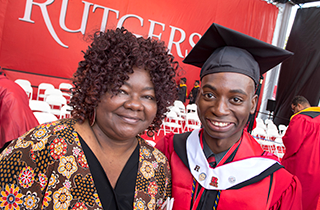
Since our founding 250 years ago, we have granted more than 585,000 academic degrees. Amazing to say, because we were a small college for so much of our history, the vast majority of people who ever graduated from Rutgers are living today—and they are watching what we do.
These graduates have seen Rutgers–New Brunswick listed among the top 25 public universities in the nation in the U.S. News and World Report and Wall Street Journal/Times Higher Education rankings, and its graduate programs in African-American History, School Library Media, and Women’s History ranked #1 by U.S. News.
They have watched our student, faculty, and staff ranks become ever more diverse and the competitiveness of our admissions continue to rise. This year we had a record 41,000 first-year applications.
They have seen us ranked in a best-for-veterans listing by Military Times as #2 in the country among four-year colleges, and Rutgers University–Camden named as New Jersey’s first Purple Heart University for its services to student veterans and their families.
They are watching us fulfill the great potential of the 2012 Higher Education Restructuring Act by forming Rutgers Health and collaborating with RWJBarnabas Health to better serve the health care needs of the state.
And they have learned from our economic impact report that Rutgers supports nearly 58,000 jobs statewide and generates $5.2 billion in annual economic activity in New Jersey—nearly a seven-to-one return for every dollar of state investment.
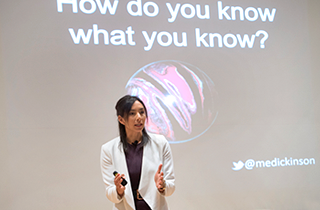 Our alumni have read about—and in many cases contributed to—a record-breaking year in fundraising, topping $200 million in private gifts for the first time in Rutgers history.
Our alumni have read about—and in many cases contributed to—a record-breaking year in fundraising, topping $200 million in private gifts for the first time in Rutgers history.
They have applauded our students’ success on the debate stage, in national and international competitions, on the wrestling mat and the soccer field, in earning Fulbrights and other academic fellowships, and even in performance with Imagine Dragons this June on the Tonight Show stage.
And our alumni have now welcomed into their ranks the first cohort of Rutgers Future Scholars, young people from our host cities who have been preparing for Rutgers since they were rising eighth graders.
As I will outline in the following report, Rutgers has honored the accomplishments of our predecessors of the past 250 years by meeting our mission of teaching, research, and service in the past year with dedication, with vision, and with creativity. And just as we took exceptional pride in the scores of accomplished alumni who marked our 250th birthday last November with inspiring lectures on A Day of Revolutionary Thinking, I believe we have given our alumni continued cause for pride. This was certainly the case in our actions during a politically eventful time in America.
Confronting Difficult Issues
The past 18 months have brought a range of emotional and controversial social issues into focus at Rutgers and on university campuses across the country. An overarching concern is how individual institutions dealt with these issues on their own campuses. I am proud to say that the Rutgers community has consistently provided examples of how such difficult topics, with varied and strongly held views, can be openly and civilly debated.
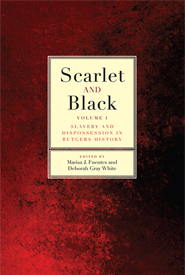 Ignited by local and national events, including police-involved deaths, the Black Lives Matter movement generated widespread debate at Rutgers during 2016. During these stressful times for so many in our community, faculty and students staged a range of discussions and conversations. One group of Rutgers–New Brunswick scholars produced a remarkable report on our own troubled early history. The Committee on Disenfranchised and Enslaved Populations issued their first volume of Scarlet and Black, which confronts our founders’ participation in the slave trade, our debts to the many enslaved men and women consigned to build our university, and our university’s role in displacing the Lenni Lenape.
Ignited by local and national events, including police-involved deaths, the Black Lives Matter movement generated widespread debate at Rutgers during 2016. During these stressful times for so many in our community, faculty and students staged a range of discussions and conversations. One group of Rutgers–New Brunswick scholars produced a remarkable report on our own troubled early history. The Committee on Disenfranchised and Enslaved Populations issued their first volume of Scarlet and Black, which confronts our founders’ participation in the slave trade, our debts to the many enslaved men and women consigned to build our university, and our university’s role in displacing the Lenni Lenape.
While our early history is disturbing, our response to this new knowledge has been inspiring. The report itself was developed through the combined efforts of faculty, graduate students, and undergraduates—a true collaboration among scholars. The committee also issued a series of recommendations for recognizing and atoning for our past actions without erasing our history. This year, as part of the University’s response to their report, the Board of Governors approved the renaming of three spaces at Rutgers–New Brunswick to reflect our history: the Sojourner Truth Apartments at the Yard; the James Dickson Carr Library on Livingston, named for Rutgers’ first African American graduate; and Will’s Way at the Old Queens Building, which honors an enslaved man who laid the foundation for the heart of the New Brunswick campus.
Last fall, shortly after Donald Trump won the presidency, large groups of Rutgers students organized rallies in New Brunswick, Newark, and Camden to express their solidarity with immigrants in our community, declare their commitment to tolerance, inclusivity, and civil discourse, and convey their concern about the anti-immigration language that had dominated so much of the presidential election.
In New Brunswick, for example, the students marched peacefully from Voorhees Mall, down George Street, and to the Douglass Student Center. Their march was joined by counter-protestors, who also demonstrated peacefully for their point of view. Images of Rutgers students, faculty, and members of our community from every background, marching in the spirit of peace and tolerance, were broadcast on the national news. That was a proud day for anyone associated with Rutgers University, as our students set an example for civil discourse in a nation torn by partisan conflict.
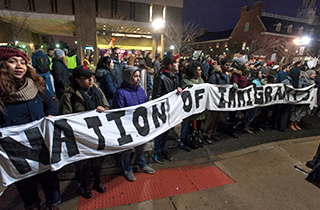 In January, the so-called “travel ban” barred entry to the United States from several Muslim-majority countries in the Middle East. Once again, our campus communities rallied to the protection of classmates, teachers, and researchers who were affected by this ban. Members of our Immigrant Rights Center at the Rutgers Law School, as well as faculty and students, joined efforts at airports to provide legal assistance to valid visa holders detained at the point of entry. The next week, large numbers again gathered across our campuses to protest what they viewed as an unconstitutional ban on immigration.
In January, the so-called “travel ban” barred entry to the United States from several Muslim-majority countries in the Middle East. Once again, our campus communities rallied to the protection of classmates, teachers, and researchers who were affected by this ban. Members of our Immigrant Rights Center at the Rutgers Law School, as well as faculty and students, joined efforts at airports to provide legal assistance to valid visa holders detained at the point of entry. The next week, large numbers again gathered across our campuses to protest what they viewed as an unconstitutional ban on immigration.
In the spring, the University leaders organized around yet another political crisis: the threat of sharp cuts to the funding budgets of federal agencies, including major sources of support like the National Science Foundation, National Institutes of Health, and National Oceanic and Atmospheric Administration. Working with our Association of American Universities (AAU) and Big Ten counterparts, we argued through our U.S. Representatives and Senators for the critical role that federal funding plays in higher education and in the well-being of our country. For now, the budget situation appears stable, but we will be watching carefully as funding for higher education will continue to be scrutinized by lawmakers.
Threats to undocumented immigrants, restrictive bans on visas, proposals to dramatically reduce research expenditures, and most recently the hateful language and violence we witnessed in Charlottesville: each of these issues has driven to the core of our broader educational mission. Any one of them could have led to violence on our campuses. Thanks to the tolerance and commitment to civil discourse of our academic community, they did not. We cannot predict with any certainty what challenges we will face this year, but we do know these challenges will include individuals who seek instability, who will appeal to the worst parts of our natures, and who will be most satisfied by silencing sincere and open dialogue about our collective values.
Whatever challenges arise, I can assure our community of this: Rutgers will tirelessly advocate for the rights of all members of our community against any political or public policy actions that impede our intellectual, social, and civic duties as the State University of New Jersey.
OUR 250TH ANNIVERSARY YEAR
Just like we hold on to being 39 until the day we turn 40, our university will still be 250 years old until November 10. And what an anniversary celebration it has been.
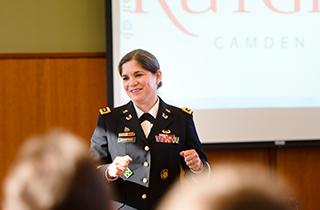 Hundreds of activities in Camden, Newark, and New Brunswick marked our commemoration, including academic lectures, books, and three 250th Anniversary Presidential Symposia on the Future of Higher Education. Our history was captured in images and stories through photo displays, videos, and an illustrated history. The RevolUtionary monument, created and donated by our friends at Johnson & Johnson, built pride on every campus it visited—and helped us raise money for scholarships.
Hundreds of activities in Camden, Newark, and New Brunswick marked our commemoration, including academic lectures, books, and three 250th Anniversary Presidential Symposia on the Future of Higher Education. Our history was captured in images and stories through photo displays, videos, and an illustrated history. The RevolUtionary monument, created and donated by our friends at Johnson & Johnson, built pride on every campus it visited—and helped us raise money for scholarships.
Our first universitywide Rutgers Day in 2016 drew more than 100,000 people (and we had another 103,000 this year). We took the Rutgers 250 celebration on the road, too, including the State House in Trenton, the U.S. Botanic Gardens in Washington, D.C., and the University of Utrecht in the Netherlands.
Most memorably of all, we celebrated our historic 250th Anniversary Commencement with then-President Barack Obama, who told us that “America converges here” as he inspired a record crowd at High Point Solutions Stadium that included graduating students from New Brunswick, Newark, Camden, and RBHS.
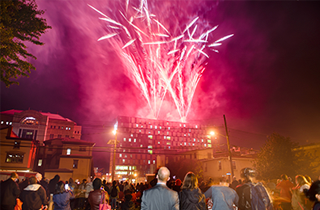 The final event, A Day of Revolutionary Thinking, which was capped by fireworks in New Brunswick, Newark, and Camden, was a fantastic way to showcase two of the greatest assets of our university: our constant quest for new knowledge and the achievements of our great alumni. Kudos and congratulations to everyone at Rutgers who contributed to the yearlong anniversary events, which are summarized in a final report available online. Rutgers 250 not only saluted our history but also raised our profile, showing the world that our revolutionary spirit is alive and well today.
The final event, A Day of Revolutionary Thinking, which was capped by fireworks in New Brunswick, Newark, and Camden, was a fantastic way to showcase two of the greatest assets of our university: our constant quest for new knowledge and the achievements of our great alumni. Kudos and congratulations to everyone at Rutgers who contributed to the yearlong anniversary events, which are summarized in a final report available online. Rutgers 250 not only saluted our history but also raised our profile, showing the world that our revolutionary spirit is alive and well today.
I’m pleased to say that the Rutgers 250 effort has been recognized for its excellence by the International Festivals and Events Association, which honors major events like the Macy’s Thanksgiving Parade and the National Cherry Blossom Festival. Rutgers 250 won 26 awards this year—including 15 Gold Awards—in categories such as TV, media, social media, websites, and merchandise. This is on top of the 2016 Gold Award that we earned from the Council for Advancement and Support of Education for our commemorative book, Rutgers: A 250th Anniversary Portrait.
PROMOTING STUDENT SUCCESS
This month Rutgers welcomed 8,400 first-year undergraduates—the second-largest entering class in our history—along with 4,850 transfer students. These newest Scarlet Knights, Raiders, and Raptors are a diverse and accomplished bunch: 130 were high school valedictorians or salutatorians, they represent a wide range of racial and ethnic backgrounds, and 4,800 are the first in their family to attend college. Our new undergraduates come from more than 40 states and nearly 50 countries. They join a community of scholars that has distinguished itself in many ways.
Student Achievement
Indeed, the past year proved phenomenally successful in showing the world the talent of our outstanding students. In competition after competition, Rutgers student teams excelled.
Last fall, a group of five Rutgers–New Brunswick economics and finance majors won the national College Fed Challenge sponsored by the Federal Reserve in Washington, D.C. Giving a presentation in the Fed boardroom that analyzed current economic conditions and offered a recommendation on monetary policy, our team defeated final-round competitors from schools such as Princeton, Dartmouth, and the University of Chicago.
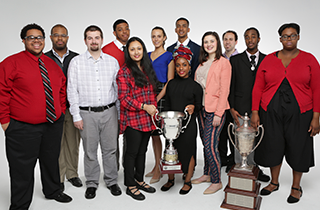 This spring, the Rutgers–Newark Debate Team won two national championships in the same week—a feat that has happened only one other time in U.S. debate team history. Shortly after that, Rutgers business students won the CME Group Trading Challenge over hundreds of schools from here and abroad, and our graduate students won the HUD Innovations in Affordable Housing competition.
This spring, the Rutgers–Newark Debate Team won two national championships in the same week—a feat that has happened only one other time in U.S. debate team history. Shortly after that, Rutgers business students won the CME Group Trading Challenge over hundreds of schools from here and abroad, and our graduate students won the HUD Innovations in Affordable Housing competition.
And just last weekend at the United Nations, a four-person team from Rutgers Business School earned first place—and a $1 million grand prize—in the global Hult Prize competition, which rewards social entrepreneurism.
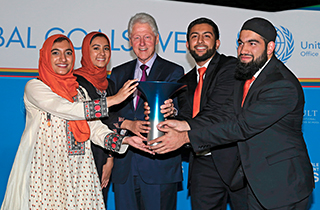 Beating counterparts from Harvard and from universities in Canada and Mexico in the final round, our student/alumni team was recognized for Roshni Rides, their innovative plan to establish a reliable, affordable rickshaw shuttle service for urbanized refugees in South Asia.
Beating counterparts from Harvard and from universities in Canada and Mexico in the final round, our student/alumni team was recognized for Roshni Rides, their innovative plan to establish a reliable, affordable rickshaw shuttle service for urbanized refugees in South Asia.
At the same time, our students and recent graduates have been earning prized fellowships and scholarships for study abroad, including the Gates Cambridge, Goldwater, National Science Foundation, Truman, Rangel, Princeton in Asia, and Beinecke scholarships. Fifteen from Rutgers won Fulbright U.S. Student Grants for the coming year that are taking them to Colombia, the Czech Republic, Germany, Greece, India, Indonesia, Malaysia, Spain, the Slovak Republic, South Korea, Sri Lanka, and Taiwan.
With each of these distinctions, hard-earned and well-deserved by these talented women and men, Rutgers’ reputation for excellence continues to grow across the country and around the world.
 And we can all take enormous pride in the many Rutgers–New Brunswick students whose dedication enabled the 2017 Rutgers University Dance Marathon to set a new record. For the first time in the Dance Marathon’s proud history, our students surpassed the $1 million mark in raising money for the Embrace Kids Foundation in support of children living with cancer, sickle cell, and other health challenges.
And we can all take enormous pride in the many Rutgers–New Brunswick students whose dedication enabled the 2017 Rutgers University Dance Marathon to set a new record. For the first time in the Dance Marathon’s proud history, our students surpassed the $1 million mark in raising money for the Embrace Kids Foundation in support of children living with cancer, sickle cell, and other health challenges.
Improving the Student Experience
One of our top priorities last year was to strengthen the atmosphere in which our students live, study, work, and socialize. That work continues.
 Our 2014 University Strategic Plan set as a goal that Rutgers offer a more personalized and institutionally streamlined student experience. As part of our work to achieve that goal, the University embarked on a Student Experience Improvement Initiative to make it easier for our students to navigate processes such as registering for classes, receiving financial aid, and paying their tuition bill. This initiative reflects our dedication to providing services aligned with students’ needs and aligned with the expectations associated with a world-class institution. Our intent is to create a virtual and physical one-stop shop for student accounting, financial aid, and records at each Rutgers campus.
Our 2014 University Strategic Plan set as a goal that Rutgers offer a more personalized and institutionally streamlined student experience. As part of our work to achieve that goal, the University embarked on a Student Experience Improvement Initiative to make it easier for our students to navigate processes such as registering for classes, receiving financial aid, and paying their tuition bill. This initiative reflects our dedication to providing services aligned with students’ needs and aligned with the expectations associated with a world-class institution. Our intent is to create a virtual and physical one-stop shop for student accounting, financial aid, and records at each Rutgers campus.
Last year, in the first phase of this project, we introduced a new Financial Aid website, greatly increased our social media presence, and implemented a check-in app at the financial aid office. These measures allow us to directly assess the student experience as they engage with Financial Aid in person and online. We have seen a significant spike in visits to the website, a nineteen-fold increase in Twitter interactions, and, through the check-in app, a reduction in average wait times for service in the office from 10 minutes to 2 minutes.
Moving beyond the website, universitywide and campus working groups have formulated space and staffing models for these new physical service locations. Students seeking advice or requiring assistance with University business will be able to find help at one location—no longer needing to bus from office to office. Newark already has co-located some key offices but is expanding to be more comprehensive. To serve New Brunswick, ASB I on the Busch campus will be renovated to provide a centralized location for student financial aid, records, and accounting.
Also critical to improving the student experience is reducing the time students spend on the buses going to and from class. Two ongoing initiatives are directed at this goal.
A task force on transportation, housing, and scheduling at Rutgers–New Brunswick, led by Executive Vice President Tony Calcado and School of Arts and Sciences Executive Dean Peter March, has been working to make key scheduling elements align in ways that keep students off overcrowded buses as much as possible. First-year housing has been assigned to reduce travel, a dedicated bus lane has been established on College Avenue, and classroom assignments have been changed to minimize student travel time.
The next major step in this effort is implementation of a comprehensive electronic scheduling system that will (1) reduce the scheduling bottlenecks that can delay some students’ time to degree, (2) reduce course-related travel, and (3) optimize the scheduling of classroom space from semester to semester. We hope to have the new system installed this winter so it can be used to set the schedule for the fall 2018 semester.
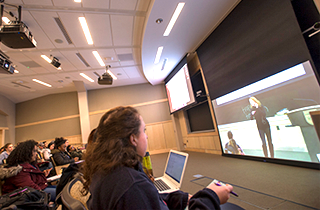 This fall is the second semester in which we are benefiting from synchronous lecture halls on the Cook and Busch campuses at Rutgers–New Brunswick that enable students to take the same course with the same professor while sitting in classrooms in two different locations, thus reducing student travel. Last spring, 11 courses, enrolling 1,730 students, took place in these innovative classrooms.
This fall is the second semester in which we are benefiting from synchronous lecture halls on the Cook and Busch campuses at Rutgers–New Brunswick that enable students to take the same course with the same professor while sitting in classrooms in two different locations, thus reducing student travel. Last spring, 11 courses, enrolling 1,730 students, took place in these innovative classrooms.
We worked closely with the faculty members who pioneered this concept last semester and made adjustments to address logistical and technical concerns. Surveys of those faculty and their students have helped us make additional tweaks to maximize their impact. The 11 courses being taught this fall in these “telepresence classrooms” include introduction to logic, exercise physiology, the life of primates, theater appreciation, law and politics, the evolution of sex and gender in animals, and the science of food.
I’m happy to note that a room in the new Nursing and Science building at Rutgers–Camden has been equipped with the same synchronous technology, and we will soon be establishing a telepresence classroom at Rutgers–Newark. This will provide the opportunity to link classes across the University.
Financial Assistance Programs
A year ago I reported on the introduction of new financial assistance initiatives at both Rutgers University–Newark (“RU-N to the Top”) and Rutgers University–Camden (“Bridging the Gap”). Both programs are designed to make it possible for students whose family income is $60,000 or less to attend by guaranteeing that their tuitions would be fully covered. In both cases, the first year of the program was highly successful.
At Newark, where the program targets Newark residents and New Jersey county college graduates, more than 680 students received RU-N to the Top support. It also provided residential scholarships for 163 students admitted to the Honors Living-Learning Community.
At Camden, where the program also covers a portion of tuition for those with adjusted gross incomes of up to $100,000, the first-year class saw a 55 percent increase, including an 83 percent increase in African-American students and 61 percent rise in Hispanic students. This past year, Rutgers–Camden introduced a full-scholarship program that is attracting students from across the country to its MFA program in creative writing.
It is imperative that we keep college affordable for students and families at all of our schools, and I’m pleased to report that Rutgers has held undergraduate tuition and fee increases to about 2 percent in each of the past four years—including 1.85 percent for the 2017-18 academic year.
FISCAL AND ADMINISTRATIVE INITIATIVES
Our commitment to keep tuition and fee increases low must be balanced against our obligation to honor union contracts governing compensation of our faculty and staff and our pursuit of new projects to improve the University. To achieve this balance, we must maintain a position of financial strength and stability, work diligently to reduce operating expenses, and ensure that we conduct our business as efficiently as possible.
Finances and Fundraising
There is good news from the summer to report regarding our financial position. In June, Moody’s Investors Service reviewed its bond rating for Rutgers. In light of the preceding downgrade of the state’s credit rating, the second in the past two years, many were predicting that Rutgers, because of our state support, would also face a drop in its credit rating. After meeting with Rutgers management and thoroughly reviewing our financial position and future plans, Moody’s elected to strengthen our credit rating, moving us from Aa3 negative to Aa3 stable. Rutgers is one of only two state universities in the country that are rated as many as three levels above their state. Moody’s cited our effective financial management, our enrollment growth, the strengthening of our brand, our diversified revenue, and our clear strategic plan among our credit strengths.
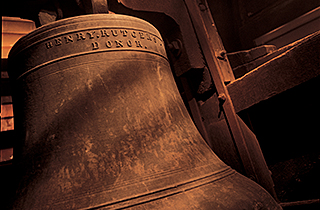 I also can report that the University’s endowment continues to show healthy growth. The total endowment market value on June 30 was $1.2 billion, a 73 percent increase over Rutgers’ $693 million total five years earlier. Several factors contributing to this dramatic increase are the integration of UMDNJ into Rutgers, which brought us new assets; our investments in a healthy stock market; and the growing success of our fundraising efforts.
I also can report that the University’s endowment continues to show healthy growth. The total endowment market value on June 30 was $1.2 billion, a 73 percent increase over Rutgers’ $693 million total five years earlier. Several factors contributing to this dramatic increase are the integration of UMDNJ into Rutgers, which brought us new assets; our investments in a healthy stock market; and the growing success of our fundraising efforts.
Of course, fundraising is vital to everything we hope to achieve, and we have made notable progress in increasing the amount of private gifts coming to Rutgers over the past five years. I am pleased to report that in fiscal 2017 the Rutgers University Foundation, led by Nevin Kessler, set a new fundraising record—by 11 percent over our next highest year—in raising $209.1 million. This record total includes transformational gifts for the arts and theater, for athletic facilities, and for children’s health. Our private fundraising for the year is more than double the amount Rutgers had raised in the year before I joined the institution.
But we have to keep up the momentum. As we begin to plan for the next capital campaign, raising $200 million per year needs to be the new standard for Rutgers. Under the leadership of Nevin and his team at the Foundation, I’m confident we can do it. In fact, our fundraising is already running 13 percent above where we were at this point last year—and that doesn’t even include two very large gifts that we will be announcing in the coming months. We are glad for these remarkable gifts and the confidence in Rutgers that they so clearly demonstrate.
Cornerstone
While our finances and fundraising are moving in a very promising direction, we have a lot of work to do in making certain that our systems infrastructure will allow us to conduct business at peak effectiveness.
On a positive note, we have finally completed our move from the crazy quilt of e-mail systems and servers that used to hinder our communication, replacing it with Rutgers Connect, a single universitywide, cloud-based product that enhances security and makes it easier to collaborate. All faculty and staff e-mail accounts have now been migrated to Rutgers Connect, which has also consolidated more than 100 departmental e-mail servers. Beyond its improved security—marking hundreds of thousands of messages as spam each week—Rutgers Connect is enabling Skype calls, video conferencing, and the storage of more than 6 million files.
We have also made significant progress on Cornerstone, our long-term plan to overhaul our business processes and the technological infrastructure by which we operate the University. The Cornerstone team, led by Executive Vice President Mike Gower and Senior Vice President Michele Norin, rolled out major new systems last year for budget planning, human resources and payroll, expense management, procurement, and grant and contract accounting.
These massive changes replaced unwieldy and outdated processes that hampered our effectiveness. The changes integrated legacy UMDNJ and legacy Rutgers systems into one; they are placing better tools in the hands of our employees; they have increased accountability under the RCM budgeting model; and as we move forward they will save us both time and money.
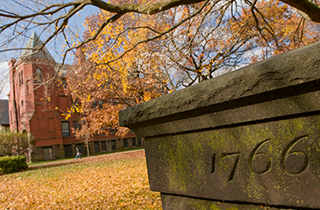 Many aspects of this system have worked well—for example, the payroll conversion from Banner. Yet in the rollout of the past year, many critical functions did not convert to the new system as planned, causing delays in payments to vendors, in reimbursements, in the administration of grants, and in the generation of departmental reports. While some glitches are expected with changes of this scale, the magnitude of the problems we experienced has caused understandable frustration.
Many aspects of this system have worked well—for example, the payroll conversion from Banner. Yet in the rollout of the past year, many critical functions did not convert to the new system as planned, causing delays in payments to vendors, in reimbursements, in the administration of grants, and in the generation of departmental reports. While some glitches are expected with changes of this scale, the magnitude of the problems we experienced has caused understandable frustration.
At this point, the financial systems are fully implemented and working normally. However, problems with reports and other interfaces with the user community continue to be impediments to full functionality at the school and faculty level. The Cornerstone team is working hard to make key reports available and easier to access, and a review of grant accounting is ongoing to ensure that grant and contract demographic data is fully converted to the Oracle system.
Our financial systems must ensure that we have clear view of our institution’s financial well-being, but we must be sure that these systems do not impede our academic and research missions. I want to thank everyone in our community for their patience and for their tremendous efforts pushing through the challenges of the system conversions. Teams of people in the procurement office worked through winter break, and hundreds of business managers have attended training and worked with the helpdesks to learn and navigate the new systems. Many others are working every day to address remaining issues and to improve the user experiences of the new system.
Much work still lies ahead in updating our administrative systems. This year we are redesigning the Human Resources and Payroll business process, under the guidance of Senior Vice President Vivian Fernandez. In addition, we will be strengthening analytics capabilities both universitywide and within divisions; making improvements to systems for research administration, financial management, and budget and planning; and implementing more efficient approaches to procurement and supply chain management.
As noted earlier in this report, we also will be redesigning and improving processes and services for students, including one-stop centers. And based on feedback from staff and faculty, the Cornerstone team is working hard to improve communications about and training for the new systems and processes.
Research and Development
In our University Strategic Plan, Rutgers committed to increase its support of research and development, including advanced research computing and the commercialization of our faculty’s discoveries and inventions. Under the leadership of Senior Vice President Christopher Molloy, these initiatives saw significant advances during Fiscal Years 2016 and 2017.
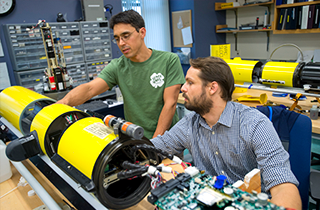 Each year, universities around the world are ranked according to the number of U.S. utility patents they have been granted; over the past several years, Rutgers has moved from 68th in the world (for 28 patents granted in 2012) to 21st in the world (for 84 patents granted in 2016). To give you a sense of the wide range of these discoveries, I note that our recently patented Rutgers inventions include a method of fabricating a reusable foam that can be used to clean up maritime oil spills; a lure that efficiently attracts bed bugs to a trap; and a technology that makes oral dosing possible for otherwise injectable-only medications.
Each year, universities around the world are ranked according to the number of U.S. utility patents they have been granted; over the past several years, Rutgers has moved from 68th in the world (for 28 patents granted in 2012) to 21st in the world (for 84 patents granted in 2016). To give you a sense of the wide range of these discoveries, I note that our recently patented Rutgers inventions include a method of fabricating a reusable foam that can be used to clean up maritime oil spills; a lure that efficiently attracts bed bugs to a trap; and a technology that makes oral dosing possible for otherwise injectable-only medications.
Another recent invention—a method developed by professors Peter Lobel and David Sleat for treating late infantile Batten disease, a fatal childhood disease—has been monetized to bring the University $9.75 million in licensing revenue. We have reinvested some of these dollars to establish a new, early-stage technology development fund, TechAdvance. The fund, which was announced in June, will make grants of up to $100,000 to help Rutgers researchers take inventions with clear commercial potential and put them on the path to become marketable products and services.
TechAdvance grants will support the critical stage of R&D that occurs just after basic research, when the technology is considered too early to attract investors or industry partners. We will rely on reviewers from industry to evaluate applications to ensure these grants go to the technologies with the greatest potential to succeed.
FACULTY AND ACADEMIC EXCELLENCE
The most valuable resource we can provide our students is the expertise and inspiration of a gifted faculty that is given the support it needs to succeed. We must continue to foster and reward outstanding teaching, build upon our academic strengths, provide the best tools for instruction, and organize our academic units to maximize their effectiveness in the 21st century higher education environment.
Faculty Honors
Each year we are reminded of the high quality of our faculty by their induction into preeminent societies or their receipt of prestigious awards. Here are a few of these honors from the past year:
- Professor Martin L. Yarmush, of the Department of Biomedical Engineering in the School of Engineering at Rutgers–New Brunswick, was elected to the National Academy of Engineering.
- Mathematics professors Natasa Sesum, Alex Kontorovich, and Jeff Kahn and physicist Gabriel Kotliar, all of the School of Arts and Sciences–New Brunswick (SAS), were named Simons Fellows. Only MIT had as many faculty awarded Simons fellowships this year.
- Last year, ten professors from Rutgers–New Brunswick and RBHS were named fellows of the American Association for the Advancement of Science—the most we have had in any year: Clinton Andrews of the Edward J. Bloustein School of Planning and Public Policy and SAS; Suzie Chen and Ah-Ng Tony Kong of the Ernest Mario School of Pharmacy; G. Charles Dismukes of SAS and the Waksman Institute of Microbiology; Henry B. John-Alder of the School of Environmental and Biological Sciences (SEBS); Terri Goss Kinzy, Peter Lobel, and Monica Roth of the Robert Wood Johnson Medical School; Pal Miliga of SEBS and the Waksman Institute; and Senior Vice President for Research and Economic Development Christopher Molloy.
- Professor Henryk Iwaniec, of the SAS Department of Mathematics, was awarded the American Mathematical Society’s Joseph L. Doob Prize, which recognizes a recent research book with potential to have a lasting impact.
- Alec Gates, Rutgers–Newark geologist, received the Geological Society of America’s 2017 Public Service Award.
- Physics professor Natan Andrei of SAS received the 2017 Lars Onsager Prize from the American Physical Society. This marks the third time since 2010 that one of our physicists has won this award; no other university in the country has won it more than twice in the past decade.
- Rachel Hadas, professor in the Department of English and the MFA in Creative Writing Program at Rutgers University–Newark, was short-listed for the 2016 Forward Prize for her poem, “Roosevelt Hospital Blues.”
- SAS professor of geography and New Jersey state climatologist David Robinson received the 2017 Life Achievement Honors from the American Association of Geographers.
- Four of our faculty members were named Guggenheim Fellows this year: Rutgers University–Camden English professors Patrick Rosal and Gregory Pardlo, and from Rutgers–New Brunswick, Rogelio Martinez in the Theater Arts department at Mason Gross School of the Arts and Jochen Hellbeck, professor of history in SAS.
- Professor Fernando Muzzio of the chemical and biological engineering department in the School of Engineering was named Inventor of the Year by the New Jersey Inventors Hall of Fame for his critical work in continuous manufacturing of pharmaceutical products.
Mergers of Schools and Higher Rankings
On July 1 we completed the third merger of Rutgers schools in the past five years with the creation of a new School of Graduate Studies that combines the programs of the former Graduate School–New Brunswick and the former Graduate School of Biomedical Sciences.
 The new entity supports more than 5,000 students enrolled in 63 doctoral programs and 75 master’s degree programs in New Brunswick and Newark. We have been planning for this merger since the integration of Rutgers and UMDNJ in 2013. The merger not only creates administrative efficiencies but also puts us on par with our AAU and Big Ten partner institutions in the structure of our graduate studies. I know it will also foster new opportunities for research and scholarship—and career preparation—as we bring together faculty and students from the biomedical, biological, social, and physical sciences, and the arts and humanities.
The new entity supports more than 5,000 students enrolled in 63 doctoral programs and 75 master’s degree programs in New Brunswick and Newark. We have been planning for this merger since the integration of Rutgers and UMDNJ in 2013. The merger not only creates administrative efficiencies but also puts us on par with our AAU and Big Ten partner institutions in the structure of our graduate studies. I know it will also foster new opportunities for research and scholarship—and career preparation—as we bring together faculty and students from the biomedical, biological, social, and physical sciences, and the arts and humanities.
Rutgers has already enjoyed strong benefits from the recent mergers of our law schools and our nursing programs in Newark and New Brunswick. Last fall we welcomed the first class to enroll in the fully merged Rutgers Law School, which saw its U.S. News & World Report ranking jump 30 places, from 92nd to 62nd in the nation. We want to see that ranking continue to rise, but the immediate improvement is very encouraging. The law school also entered the top 50 rankings of Above the Law, which focuses primarily on job placement, and was cited by U.S. News for its graduates having the lowest average debt.
The 2014 merger of the College of Nursing and the former UMDNJ School of Nursing produced a school of the highest quality that has quickly paid dividends. Last year, the School of Nursing was ranked 20th in the nation by U.S. News for graduate education, and extramural support for the school grew by 38 percent from 2016 to 2017.
I’m pleased to say that a number of academic programs across Rutgers have been climbing in the national rankings. For example, the full-time MBA program at Rutgers Business School–Newark and New Brunswick rose by 11 places to enter the nation’s top 50 in U.S. News, and our part-time MBA program did even better, jumping 31 spots to rank 38th in the nation.
Sixteen different majors at Rutgers–New Brunswick—as varied as health professions, music, urban studies, biological sciences, human resource management, public health, nutrition, and meteorology—have been ranked in the Top 10 for 2018 by USA Today/College Factual.
Humanities Task Force
Maintaining Rutgers’ historic strength in the humanities is a foundational element of our University Strategic Plan, and it is central to a comprehensive undergraduate education and to preparing scholars for careers in teaching and research. We continue to boast highly ranked programs in history, philosophy, English, and women’s and gender studies, and we need to maintain—or even improve—our reputation in these areas as the University changes and grows.
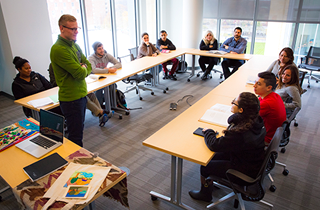 Last year I accepted the report of the Task Force on the Humanities, led by Senior Vice President Barbara Lee and with representation from Newark, New Brunswick, RBHS, and Camden. The report provided thoughtful recommendations for action by faculty, deans, and the central administration. In response, I committed $10 million to strengthen the humanities on all of our campuses, in conjunction with my previous commitment of $21.7 million for diverse faculty hiring (which brought to Rutgers an additional 33 faculty members this fall).
Last year I accepted the report of the Task Force on the Humanities, led by Senior Vice President Barbara Lee and with representation from Newark, New Brunswick, RBHS, and Camden. The report provided thoughtful recommendations for action by faculty, deans, and the central administration. In response, I committed $10 million to strengthen the humanities on all of our campuses, in conjunction with my previous commitment of $21.7 million for diverse faculty hiring (which brought to Rutgers an additional 33 faculty members this fall).
We have already begun to see benefits from our investment. For example, $2.5 million will be used to support our outstanding writing programs in Camden and Newark. With its initial allocation, Rutgers–Camden is funding graduate students who will teach writing to first-year students, and the quality of the applicant pool of MFA candidates has already increased because of these additional fellowships. Newark is using a portion of this funding to hire a creative nonfiction writer.
Departments have also used some of the investment for advance salary support to recruit nationally renowned scholars in anticipation of the retirement of longtime distinguished faculty. For example, at Rutgers–New Brunswick we have hired a senior scholar in Victorian literature, two senior scholars in African American history, a junior scholar in linguistics syntax, and—with a Henry Rutgers Professorship—a distinguished professor of philosophy from Harvard.
Among our goals for the humanities is to recruit outstanding doctoral students, and as an example of our early success, the Rutgers–New Brunswick history department has recruited 13 new PhD students with the help of Presidential Excellence Summer Stipends of $10,000 to be used in their first two years in the program.
With help from our investment, humanities faculty from across Rutgers have also developed a two-year program with the New Jersey Council for the Humanities. The program will connect undergraduate and graduate students in humanities disciplines with community groups to record and understand local history, develop projects related to heritage and cultural appreciation, and create related displays for libraries and schools.
Strengthening Teaching Evaluation
Embedded in our strategic plan is the goal of excellence in teaching. As any Rutgers student knows, we are blessed with an abundance of outstanding teachers among our faculty, including members of our tenured, tenure-track, and non-tenure track faculty, our part-time lecturers, and our teaching assistants. The quality of teaching at Rutgers is very high, and we must always strive for excellence.
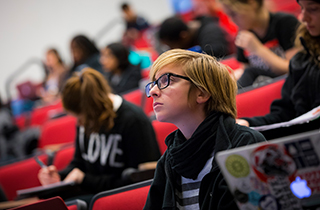 I’m pleased to say that we intend to strengthen the way we evaluate teaching for all who teach at Rutgers. A task force convened by Senior Vice President Lee has proposed a new framework that calls on each department to prepare a systematic plan for evaluation that is appropriate for that particular discipline. Each plan should include both summative evaluations, which can be used for retention, tenure, promotion, and other employment-related decisions, and formative assessments, which are designed to help faculty improve their teaching.
I’m pleased to say that we intend to strengthen the way we evaluate teaching for all who teach at Rutgers. A task force convened by Senior Vice President Lee has proposed a new framework that calls on each department to prepare a systematic plan for evaluation that is appropriate for that particular discipline. Each plan should include both summative evaluations, which can be used for retention, tenure, promotion, and other employment-related decisions, and formative assessments, which are designed to help faculty improve their teaching.
Student surveys will remain an important element of the process, but we will ask departments to also employ peer observations of teaching, review of course materials, and other tools in their evaluations. Our goal, consistent with our commitment to improve the student experience, is to identify and reward good teaching and help improve teaching where that may be needed.
Academic Unit Organization
Our strategic plan also called for a close examination of the organizational structure of academic units at Rutgers. In 2014, I charged a special Committee on Academic Unit Organization, composed of faculty from across Rutgers, to examine how best to organize our academic units, to recommend possible realignments to enhance collaborations, and to consider potential new schools that would align us more closely with other great public universities. In April, this committee submitted its final report to my office, which I then shared with the senior leadership of the University and the community broadly.
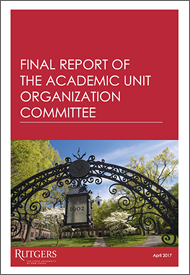 The final report is the product of a tremendous amount of hard work, research, and careful thought and discussion about the University’s current academic structure and the opportunities we have for becoming an even stronger institution. I thank the members of the committee, led by chair Linda Brzustowicz of Rutgers–New Brunswick and the late Clem Price of Rutgers–Newark, for all their efforts in tackling a difficult task.
The final report is the product of a tremendous amount of hard work, research, and careful thought and discussion about the University’s current academic structure and the opportunities we have for becoming an even stronger institution. I thank the members of the committee, led by chair Linda Brzustowicz of Rutgers–New Brunswick and the late Clem Price of Rutgers–Newark, for all their efforts in tackling a difficult task.
The committee’s recommendations include: the creation of a unit for Global Studies and a design institute; an improved institutional structure for outreach and engagement; a database to make it easier for our faculty to collaborate; efforts to improve the educational experience for nontraditional students; and a new matriculating unit for incoming first-year students in New Brunswick. Over the coming weeks, I will be working with the chancellors and the senior leadership to evaluate the feasibility of these proposals, set priorities, and establish implementation plans where appropriate. The complete report is posted for your review on the Rutgers website.
Instructional Technology
Another major outcome of the University Strategic Plan was the formation of the Committee on Near- and Long-Term Impact of Instructional Technology. In 2014, I charged this committee to recommend improvements and initiatives that would better serve the educational needs of our students. The task force submitted its final report to me earlier this month. I want to thank the co-chairs, Professors Darrin York and Susan Albin of Rutgers–New Brunswick, as well as the entire committee of faculty and technology experts, for taking on this challenging project.
The final report makes several major recommendations, including development of a sustainable budget model for instructional technology, modernization of our testing centers, and implementation of technologies to better connect our classrooms across campuses. We will soon circulate this report to the university community for comment, and, working with the chancellors, I will begin prioritizing the committee’s recommendations in the coming weeks.
NEWARK, CAMDEN, NEW BRUNSWICK, and RBHS
The higher education restructuring legislation of 2012 mandated the creation of a new chancellor position to lead each of the four major units recognized by the bill—Rutgers–Newark, Rutgers–Camden, Rutgers–New Brunswick, and Rutgers Biomedical and Health Sciences (RBHS). Rutgers has been fortunate in attracting Nancy Cantor, Phoebe Haddon, Deba Dutta, and Brian Strom to these critical leadership positions, and I know we will continue to see their focused leadership benefit their students, faculty, and staff locally and help drive the entire University’s upward trajectory.
Rutgers University–Newark
We are excited that Rutgers University–Newark is a partner in the team that is hosting a gubernatorial debate at the New Jersey Performing Arts Center in Newark in October. This is only the latest evidence of how, under the leadership of Chancellor Nancy Cantor, Rutgers–Newark continues to serve and expand upon its mission as an anchor institution for New Jersey’s largest city. Let me cite a few other examples to illustrate our involvement in Newark (an additional example is noted in the RBHS summary below).
City of Learning Collaborative: Rutgers–Newark is a critical player in the Newark City of Learning Collaborative, which seeks to increase the percentage of Newark residents holding postsecondary degrees from 17 percent (in 2015) to 25 percent by 2025. Among other projects within the collaborative, Rutgers–Newark is the lead partner in a focused effort to dramatically strengthen the culture of college-going at Malcolm X Shabazz High School, working with teachers, administrators, and community members to increase high school completion and transitions to college.
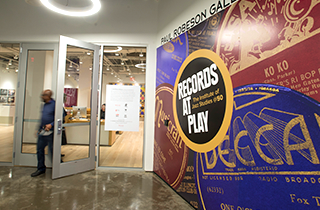 Express Newark: Express Newark, another expansive effort to forge mutually beneficial relationships between Rutgers–Newark and the city, has been a great success since it opened in January. This university-community collaboratory occupies 50,000 square feet in the restored Hahne & Company building in downtown Newark, and Rutgers–Newark faculty and staff have established programs that engage students, artists, and residents of the city in arts and culture.
Express Newark: Express Newark, another expansive effort to forge mutually beneficial relationships between Rutgers–Newark and the city, has been a great success since it opened in January. This university-community collaboratory occupies 50,000 square feet in the restored Hahne & Company building in downtown Newark, and Rutgers–Newark faculty and staff have established programs that engage students, artists, and residents of the city in arts and culture.
The space includes a 3D design and fabrication facility, print shop, photo studio, video production facility, and gallery space. Express Newark is giving our faculty remarkable opportunities to generate publicly engaged scholarship.
 Honors Living-Learning Community: Site preparation is under way at the home of Rutgers–Newark’s innovative Honors Living-Learning Community (HLLC), which will be constructed in downtown Newark. The building will house 400 students who are selected through an intensive talent search that takes into account leadership skills, grit, and commitment to social change. The HLLC curriculum includes common courses on cultural competence and other skills needed for change leadership. Some 180 faculty and staff at Rutgers–Newark are engaged as admissions evaluators, and six faculty members are selected each year to serve as faculty mentors.
Honors Living-Learning Community: Site preparation is under way at the home of Rutgers–Newark’s innovative Honors Living-Learning Community (HLLC), which will be constructed in downtown Newark. The building will house 400 students who are selected through an intensive talent search that takes into account leadership skills, grit, and commitment to social change. The HLLC curriculum includes common courses on cultural competence and other skills needed for change leadership. Some 180 faculty and staff at Rutgers–Newark are engaged as admissions evaluators, and six faculty members are selected each year to serve as faculty mentors.
Diversity and Inclusion: Two years ago, Chancellor Cantor established the Rutgers University–Newark Commission on Diversity and Transformation. Its goal has been to create curricula, scholarship, initiatives, and spaces for both intragroup solidarity and inter-cultural engagement. With wide input, the Commission this year advanced a range of recommendations—from instituting means to support excellence in publicly engaged scholarship, to developing faculty, staff, and administrator cultural competencies, to strengthening mentoring relationships. One vehicle for addressing these recommendations is the P3 Collaboratory for Pedagogy, Professional Development and Publicly-Engaged Scholarship. This center, created as an outcome of Newark’s strategic plan, is working to increase excellence in teaching and foster high impact scholarship (particularly publicly engaged scholarship), leadership development, and career success for faculty members and graduate students.
Just last month, Rutgers–Newark was named as one of the ten campuses nationwide selected by the Association of American Colleges and Universities and the Kellogg Foundation to create a Truth, Racial Healing, and Transformation Center in conjunction with partners across the Newark community. The center will deliver programming to effect racial healing and the transformation of Newark as a culturally and artistically rich community.
Rutgers University–Camden
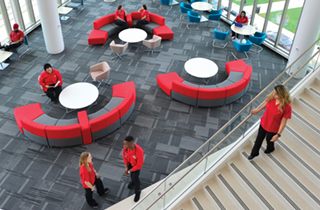 With the completion of the Nursing and Science Building, Rutgers University–Camden nursing students and faculty, as well as the physics department, have a facility that matches their excellence. I look forward to joining in the formal dedication of the building next week. Soon that facility will be complemented by a joint health sciences building being constructed by the Rowan-Rutgers–Camden Board of Governors that will give our scientists in Camden laboratory space for their research endeavors.
With the completion of the Nursing and Science Building, Rutgers University–Camden nursing students and faculty, as well as the physics department, have a facility that matches their excellence. I look forward to joining in the formal dedication of the building next week. Soon that facility will be complemented by a joint health sciences building being constructed by the Rowan-Rutgers–Camden Board of Governors that will give our scientists in Camden laboratory space for their research endeavors.
These developments are critical to our role in creating an “eds and meds” corridor in Camden that connects Rutgers with Cooper University Hospital. Camden City Hall is within that corridor, and Chancellor Phoebe Haddon is working closely with Mayor (and Rutgers alumna) Dana Redd on the “Camden Rising” redevelopment and revitalization movement. We are grateful to the Legislature and Governor Christie for the special appropriation of $5 million in the Fiscal Year 2018 state budget toward a needed new facility for the Rutgers School of Business–Camden, which we envision as another key piece of this corridor and of Camden’s new vitality.
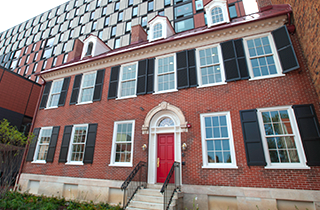 Even as we look forward to Rutgers’ future growth in Camden, we honored our rich tradition last year by opening the first-ever Alumni House on the Rutgers–Camden campus, in a building that, partially, dates back to the early 1800s—almost as old as Rutgers itself.
Even as we look forward to Rutgers’ future growth in Camden, we honored our rich tradition last year by opening the first-ever Alumni House on the Rutgers–Camden campus, in a building that, partially, dates back to the early 1800s—almost as old as Rutgers itself.
Student Experience: Rutgers–Camden has launched two new offices this fall to further advance its profound commitment to the full student experience: a student diversity and inclusion office and, to help students earn prestigious awards and nationally recognized fellowships, an Office of Scholar Development and Fellowship Advising.
Civic Engagement: Further evidence of Rutgers’ commitment to Camden is a state grant the Rutgers–Camden Office of Civic Engagement secured with the city’s nonprofit Center for Family Services to help fund a workforce development initiative, the Camden Corps Plus program. This program serves young people in Camden who have left school before earning their high school diploma and are under- or unemployed. In addition, Rutgers–Camden students are engaged in many civic activities, including a program to mentor children in North Camden schools.
The Immigrant Justice Clinic at Rutgers Law School in Camden rose to the challenge of giving critical information and assistance to hundreds of families concerned about their legal status during the past year. The Senator Walter Rand Institute for Public Affairs produced research specific to South Jersey, including a widely reported study exploring whether or not the region receives its share of state support. In these and other ways, including a day of on-campus activity by Senator Cory Booker and Congressman Donald Norcross in August, Rutgers–Camden is driving the conversation in South Jersey.
Rutgers–New Brunswick
As you know, this July we welcomed Debasish Dutta, formerly the Provost and Executive Vice President for Academic Affairs and Diversity at Purdue University, as the new chancellor of Rutgers–New Brunswick.
I want to express my appreciation again to Senior Vice President Barbara Lee and Board of Governors member Frank Hundley, who co-chaired the search committee, and to the many faculty and staff members who helped assemble a deep and talented pool of applicants for the chancellorship. I look forward to watching Dr. Dutta set to work in New Brunswick and am confident that our community will quickly feel the positive impact of his leadership.
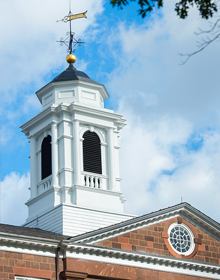 Chancellor Dutta’s appointment creates an opportunity to re-calibrate the respective roles of the President of the University and the Chancellor of New Brunswick. To ensure, symbolically, that the chancellor is understood as the leader of Rutgers–New Brunswick, his offices and those of his senior staff will be in Old Queens. In January, the President’s Office, along with members of my senior leadership team, will move to Winants Hall, which will become the permanent home of the Rutgers University president. While maintaining a central presence in New Brunswick, this move is intended to emphasize the President’s role as the leader of the entire University enterprise, including our broader academic mission as the State University of New Jersey, our central services, fiduciary oversight, and overall strategic and facilities master planning.
Chancellor Dutta’s appointment creates an opportunity to re-calibrate the respective roles of the President of the University and the Chancellor of New Brunswick. To ensure, symbolically, that the chancellor is understood as the leader of Rutgers–New Brunswick, his offices and those of his senior staff will be in Old Queens. In January, the President’s Office, along with members of my senior leadership team, will move to Winants Hall, which will become the permanent home of the Rutgers University president. While maintaining a central presence in New Brunswick, this move is intended to emphasize the President’s role as the leader of the entire University enterprise, including our broader academic mission as the State University of New Jersey, our central services, fiduciary oversight, and overall strategic and facilities master planning.
In the past year, Rutgers–New Brunswick, during the final months of Richard Edwards’ very successful tenure as inaugural chancellor, continued to grow. Here are a few highlights.
RU-1st: Under Chancellor Edwards, himself a first-generation college graduate, Rutgers–New Brunswick initiated the RU-1st Alliance, a program to provide robust resources such as additional advising to support first-generation students as well as low-income and underrepresented students. This program has particular resonance at a university that has long been and continues to be a place of opportunity for young women and men who are the first in their families to attend a four-year college. It also addresses the fact that first-generation students are four times more likely to leave college after their first year.
 America Converges Here: This spring, taking inspiration from President Obama’s memorable words at the 2016 Commencement, New Brunswick celebrated its dynamic community of scholars in a series of events, visits, and videos under the theme “America Converges Here.” The initiative highlighted the convergences of people, ideas, and place that have enriched the New Brunswick academic experience. Highlights of this initiative included talks by civil rights icon and Congressman John Lewis and Pulitzer Prize-winning journalist Jose Antonio Vargas.
America Converges Here: This spring, taking inspiration from President Obama’s memorable words at the 2016 Commencement, New Brunswick celebrated its dynamic community of scholars in a series of events, visits, and videos under the theme “America Converges Here.” The initiative highlighted the convergences of people, ideas, and place that have enriched the New Brunswick academic experience. Highlights of this initiative included talks by civil rights icon and Congressman John Lewis and Pulitzer Prize-winning journalist Jose Antonio Vargas.
Strategic Planning: Over the course of the past year, a number of special committees called for in the New Brunswick strategic plan, including task forces on the first-year student experience and on transfer students, submitted their reports and recommendations to Chancellor Edwards. These recommendations will be taken up in the coming year by Chancellor Dutta.
Rutgers Biomedical and Health Sciences
Led by Chancellor Brian Strom, Rutgers Biomedical and Health Sciences (RBHS) took important steps in the past year toward achieving the ambitions laid out in its 2014 strategic plan to build one of the best academic health centers in the country. Key appointments this year have brought to Rutgers the experience and talents of Rutgers Cancer Institute of New Jersey director Steven Libutti, an internationally respected expert in endocrine surgery, and School of Public Health dean Perry Halkitis, an award-winning scholar in HIV/AIDS, substance abuse, and mental health.
For fiscal year 2017, RBHS completely overcame an operating deficit inherited with the merger that was once, in FY14, projected to be as deep as $54 million, and is now able to project—and deliver—a breakeven budget.
Supporting Newark: RBHS and Rutgers–Newark are both involved in an initiative announced by Mayor Ras Baraka this summer, titled Hire.Buy.Live.Newark, that is committed to employing more city residents and buying more goods and services from Newark-based businesses. The initiative is a reaction to research showing that Newark’s poverty rate is double the national average and that anchor institutions are spending only 3 percent of their procurement dollars in the city. Chancellors Strom and Cantor have collectively pledged to make 220 local hires and increase local procurement spending 20 percent by 2020.
Centers and Institutes: Under the direction of Dr. Reynold Panettieri, RBHS launched a Rutgers Institute for Translational Medicine and Science that is dedicated to “delivering the right treatment to the right person at the right time.” This institute is the academic home for clinical and translational research, infrastructure, and training for RBHS, the University, and partner institutions.
The Rutgers Biostatistics and Epidemiology Services Center (RUBIES), which launched last year, enables investigators to access statistics, programming, and data analysis on a fee-for-services basis. RUBIES is quickly becoming a valuable asset for faculty; it has already been engaged in a dozen research projects in a range of health-related areas.
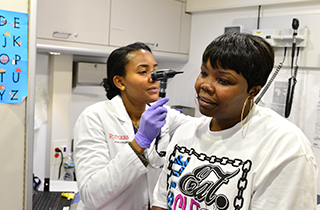 Rutgers Health: Rutgers Health, the newly formed clinical arm of the University that includes all our clinical care programs, was formally announced last year and continues to take important steps toward establishing itself as an outstanding academic health care provider organization. Rutgers Health enables us to maximize our health care-related assets to give New Jersey residents access to the very best clinical care, delivered by those who are researching new therapies to treat illness and maintain wellness.
Rutgers Health: Rutgers Health, the newly formed clinical arm of the University that includes all our clinical care programs, was formally announced last year and continues to take important steps toward establishing itself as an outstanding academic health care provider organization. Rutgers Health enables us to maximize our health care-related assets to give New Jersey residents access to the very best clinical care, delivered by those who are researching new therapies to treat illness and maintain wellness.
The Rutgers Health Group, an integrated multi-specialty faculty practice of more than 1,000 providers, will be partnering with patients, hospitals, and community clinicians to deliver high-quality health care in clinical settings throughout the state. Rutgers Health Group, whose 29-member board was seated in June, went into operation on July 1 as a separate, nonprofit subsidiary of the University to administer our academic clinical practice.
 This year RBHS launched the Rutgers Health brand within and beyond New Jersey with a marketing campaign that has included billboards, radio spots, and digital and print advertising. At the same time, we have established or deepened relationships with key clinical partners.
This year RBHS launched the Rutgers Health brand within and beyond New Jersey with a marketing campaign that has included billboards, radio spots, and digital and print advertising. At the same time, we have established or deepened relationships with key clinical partners.
As the result of extensive work last year, the University signed a letter of intent this summer with RWJBarnabas Health, the state’s most comprehensive health care delivery system, to create an academic health care system that will provide high-quality patient care, medical research, and medical education. Our clinical practitioners will be part of a 2,500-member, multi-specialty group that will be among the largest—and best—in the country. RWJBarnabas Health will lead and manage all clinical operations in coordination with Rutgers, and Rutgers will lead and manage the academic research functions in coordination with RWJBarnabas Health.
This is an enormously important agreement for Rutgers. It will enable us to recruit the finest academic and health care practitioners, set a new standard of excellence in training the next generation of physicians, dentists, and other health care professionals, and provide health care based on the latest research.
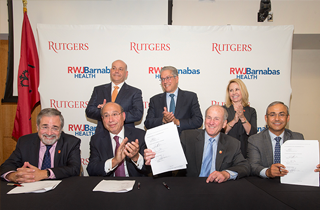 We are excited about the opportunities that will be created through this agreement with RWJBarnabas Health, which has already made a significant, $18 million investment in the Athletic Performance Center on Busch Campus (for which we broke ground last November) and in the recruitment of leadership to several key clinical departments.
We are excited about the opportunities that will be created through this agreement with RWJBarnabas Health, which has already made a significant, $18 million investment in the Athletic Performance Center on Busch Campus (for which we broke ground last November) and in the recruitment of leadership to several key clinical departments.
Let me thank Chancellor Strom, Rutgers Health CEO Vicente Gracias, and all involved in negotiating this critical and complex agreement. In that regard, I also want to applaud the efforts of Senior Vice President John Hoffman and his legal team, which was voted the best Office of General Counsel in the state, public or private, by the New Jersey Bar Association.
ENHANCING OUR PUBLIC PROMINENCE
One of the central priorities for Rutgers in the University Strategic Plan was to increase our public prominence, and we continue working hard toward that goal. While every aspect of Rutgers plays a part in building our reputation—our academic programs, our alumni, our administrative structure, our athletic teams, our star faculty—the way we communicate with our many audiences is a critical factor. We are solidly committed to raising the profile of the University in an aggressive and sustained way by taking advantage of every asset and opportunity to tell our story.
As a measure of our success, the number of news stories that mention Rutgers has increased from just over 503,000 in fiscal year 2015 to more than 769,000 in fiscal year 2017. While we did not reach the record number we had hit in 2016, when President Obama’s appearance at Commencement generated an unprecedented level of extended news coverage that helped boost the number to about 880,000, this past year’s total shows a strong upward trend as a result of our aggressive promotion of Rutgers people, innovations, and discoveries.
 In furtherance of this goal, this week the University launched a newly redesigned Rutgers Today universitywide news service, which now delivers the top Rutgers news stories to readers’ desktops every weekday morning. This improvement will keep our faculty and staff better informed than ever. Students, alumni, and friends of Rutgers can also subscribe to receive daily Rutgers news.
In furtherance of this goal, this week the University launched a newly redesigned Rutgers Today universitywide news service, which now delivers the top Rutgers news stories to readers’ desktops every weekday morning. This improvement will keep our faculty and staff better informed than ever. Students, alumni, and friends of Rutgers can also subscribe to receive daily Rutgers news.
Economic Impact Report
Rutgers has a critical service mission as the State University of New Jersey, and it is important for us to communicate that relationship with the people we serve, including our state’s elected and appointed public officials. Under the leadership of Senior Vice President Pete McDonough, our Department of External Affairs has worked closely with the Governor and legislators in Trenton and with our Congressional delegation in Washington to advocate for annual state appropriations, federal financial assistance, grant funding, and other support for higher education. As one way of demonstrating the value of these public investments, Vice President McDonough commissioned an academic study by the Edward J. Bloustein School of Planning and Public Policy to measure the economic impact that Rutgers has on New Jersey.
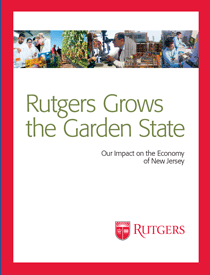 In May we released a report, Rutgers Grows the Garden State, which highlighted the key findings of the Bloustein School analysis. The report showed that Rutgers, the state’s third-largest non-government employer, supports nearly 58,000 jobs statewide, generates $5.2 billion in annual economic activity in New Jersey, and returns nearly seven dollars to the New Jersey economy for every dollar state government provides to Rutgers. Moreover, our construction projects over the past five years have also supported nearly 12,000 short-term jobs. And as former Bloustein School dean Jim Hughes wrote in an op-ed about the report, this impact does not even account for the social value of a Rutgers education, the scientific and medical advances we provide, the career-changing benefits of our continuing education programs, the expertise we share with municipalities and businesses, or the return on investment for each student who earns a Rutgers degree.
In May we released a report, Rutgers Grows the Garden State, which highlighted the key findings of the Bloustein School analysis. The report showed that Rutgers, the state’s third-largest non-government employer, supports nearly 58,000 jobs statewide, generates $5.2 billion in annual economic activity in New Jersey, and returns nearly seven dollars to the New Jersey economy for every dollar state government provides to Rutgers. Moreover, our construction projects over the past five years have also supported nearly 12,000 short-term jobs. And as former Bloustein School dean Jim Hughes wrote in an op-ed about the report, this impact does not even account for the social value of a Rutgers education, the scientific and medical advances we provide, the career-changing benefits of our continuing education programs, the expertise we share with municipalities and businesses, or the return on investment for each student who earns a Rutgers degree.
We distributed the report to elected officials and business leaders across the state and launched an online campaign—including social media—to further disseminate and promote it. I encourage everyone at Rutgers to read the report, which is available online, and continue to help us share its findings with the broader public.
RUTGERS ATHLETICS
Across Rutgers, athletics plays an important part of the student experience—from our recreation programs to our club sports and, of course, our intercollegiate sports at the Division I and Division III levels. We take pride in our student athletes and the contributions they make to our university community, both in promoting school spirit and in carrying the Rutgers name across the country.
Rutgers–New Brunswick’s Scarlet Knights have begun their fourth year in the Big Ten. Top performances last year came from the women’s soccer team, which played its way into the Big Ten championship game and earned another NCAA Division I tournament berth, and the wrestling team, which finished the dual-meet season with a 12-5 record and ranked 12th in the nation in Division I, with two All-Americans in Anthony Ashnault and Ken Theobold. The men’s lacrosse team was briefly ranked as the number one team in the country. And javelin thrower Christopher Mirabelli earned first team All-American honors at the NCAA Division I Outdoor Track and Field Championships in June. Just as important to note, thirteen of our Scarlet Knights teams tied or set program records for their scores in the NCAA’s Academic Progress Rate, a measure of success in the classroom.
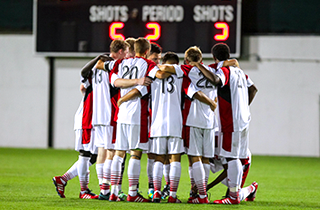 Rutgers–Newark Athletics had many strong performances in the past year, most notably the men’s soccer team, which advanced to the Elite Eight of the NCAA Division III tournament and finished the year 21-4-0. The Scarlet Raiders’ baseball and women’s volleyball teams both reached the New Jersey Athletic Conference tournament for the first time in many years, and sprinter Success Uhunmwangho became the first Rutgers–Newark athlete to compete in the NCAA Division III Track and Field Championships.
Rutgers–Newark Athletics had many strong performances in the past year, most notably the men’s soccer team, which advanced to the Elite Eight of the NCAA Division III tournament and finished the year 21-4-0. The Scarlet Raiders’ baseball and women’s volleyball teams both reached the New Jersey Athletic Conference tournament for the first time in many years, and sprinter Success Uhunmwangho became the first Rutgers–Newark athlete to compete in the NCAA Division III Track and Field Championships.
The Rutgers–Camden golf team won the North Eastern Athletic Conference championship for the fifth straight year. The Scarlet Raptors women’s basketball team qualified for the Eastern College Athletic Conference tournament for the second year in a row, as did the volleyball team. And sprinter Cameron Dobbins placed fourth in the 100-meter dash, and fifth in the 200-meter dash, at the ECAC Division III Outdoor Championships.
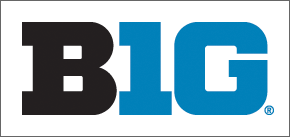 Let me offer a few words about the financial plan for Division I athletics at Rutgers–New Brunswick. I have been clear in my goal—stated in the strategic plan—of reducing support for athletics from the University’s operating budget. Specifically, I committed to bring this support to zero by fiscal year 2021, when Rutgers will become a full equity partner of the Big Ten conference. Executive Vice President Mike Gower and Athletic Director Pat Hobbs understand this expectation and have finalized a four-year financial roadmap for Division I Athletics that will help our teams compete against their Big Ten rivals while ensuring responsible and strategic spending. I will be sharing this multi-year plan, based on Big Ten distributions in FY16-17 recently confirmed in the national press, with the New Brunswick Faculty Council later this fall.
Let me offer a few words about the financial plan for Division I athletics at Rutgers–New Brunswick. I have been clear in my goal—stated in the strategic plan—of reducing support for athletics from the University’s operating budget. Specifically, I committed to bring this support to zero by fiscal year 2021, when Rutgers will become a full equity partner of the Big Ten conference. Executive Vice President Mike Gower and Athletic Director Pat Hobbs understand this expectation and have finalized a four-year financial roadmap for Division I Athletics that will help our teams compete against their Big Ten rivals while ensuring responsible and strategic spending. I will be sharing this multi-year plan, based on Big Ten distributions in FY16-17 recently confirmed in the national press, with the New Brunswick Faculty Council later this fall.
CAPITAL CONSTRUCTION
In order to become a leading public university, our strategic plan called for Rutgers to create a physical environment commensurate with preeminence in research, excellence in teaching, and commitment to community. I’m pleased to report that several long-awaited academic building projects were completed this year, to the great benefit of our students, our faculty, and the people we serve through our research.
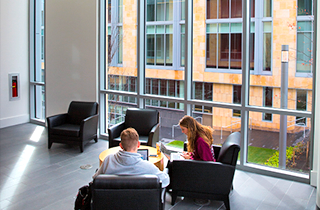 Last fall in New Brunswick, we opened the first new academic building on the College Avenue campus in many decades. Located at the end of Voorhees Mall, next door to the New Brunswick Honors College, the 175,000-square foot academic building features state-of-the-art lecture halls, offices, and interactive classrooms. Go there on a typical weekday and you’ll find it being used by more than 2,500 students and faculty.
Last fall in New Brunswick, we opened the first new academic building on the College Avenue campus in many decades. Located at the end of Voorhees Mall, next door to the New Brunswick Honors College, the 175,000-square foot academic building features state-of-the-art lecture halls, offices, and interactive classrooms. Go there on a typical weekday and you’ll find it being used by more than 2,500 students and faculty.
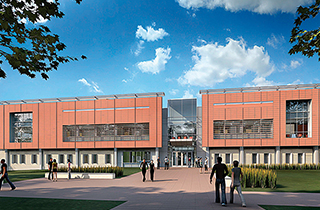 On Rutgers–New Brunswick’s Busch campus in Piscataway, the architecturally striking new Chemistry and Chemical Biology facility provides 141,000 square feet of space for specialty research laboratories as well as for conference rooms, administrative offices, and an auditorium. Also in Piscataway, a 60,000-square-foot addition to the Ernest Mario School of Pharmacy includes new lecture halls, classrooms, simulation labs, patient assessment rooms, and other vital spaces. And this summer we opened the Marco Battaglia Practice Complex, a state-of-the-art football practice facility funded entirely by private donations to Rutgers Athletics.
On Rutgers–New Brunswick’s Busch campus in Piscataway, the architecturally striking new Chemistry and Chemical Biology facility provides 141,000 square feet of space for specialty research laboratories as well as for conference rooms, administrative offices, and an auditorium. Also in Piscataway, a 60,000-square-foot addition to the Ernest Mario School of Pharmacy includes new lecture halls, classrooms, simulation labs, patient assessment rooms, and other vital spaces. And this summer we opened the Marco Battaglia Practice Complex, a state-of-the-art football practice facility funded entirely by private donations to Rutgers Athletics.
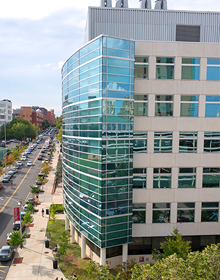 In Newark, we are completing the second phase of the Life Sciences Center, with 87,000 square feet for research labs, offices, conference rooms, and a classroom; a 29,000-square-foot fitout of the business school at 1 Washington Park to add classroom and conference space; and 26,000 square feet of renovations of the School of Dental Medicine for labs, offices, sterilizers, decontamination areas, and other uses.
In Newark, we are completing the second phase of the Life Sciences Center, with 87,000 square feet for research labs, offices, conference rooms, and a classroom; a 29,000-square-foot fitout of the business school at 1 Washington Park to add classroom and conference space; and 26,000 square feet of renovations of the School of Dental Medicine for labs, offices, sterilizers, decontamination areas, and other uses.
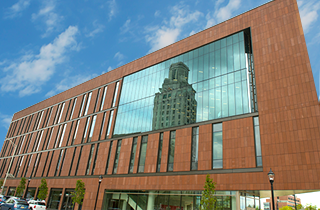 The Nursing and Science Building in Camden, an enormously important and eagerly awaited facility, opened this semester with 102,000 square feet of space for classrooms, biology and physics labs, laser and simulation labs, and an immersive lecture hall.
The Nursing and Science Building in Camden, an enormously important and eagerly awaited facility, opened this semester with 102,000 square feet of space for classrooms, biology and physics labs, laser and simulation labs, and an immersive lecture hall.
A new major project has begun in Piscataway: the RWJBarnabas Athletic Performance Center, which will give Scarlet Knights a training facility on a par with their rivals in the Big Ten and will provide the Rutgers community with first-class sports medicine. We are grateful to our partners at RWJBarnabas Health, to our state leaders in Trenton (including Senators Ray Lesniak and Tom Kean) who provided $25 million in tax credits for the training complex, and to Rutgers Athletics donors who together provided the capital needed for this project. We anticipate the facility will open in 2019.
Since the fall of 2012, Rutgers has completed or begun more than $2 billion in capital construction projects benefiting students, faculty, staff, and alumni on each of our campuses. In the coming year we will be moving forward on several major initiatives, including:
- Designing and constructing facilities on each of our University campuses to provide one-stop services for students;
- Renovating a historic building on Washington Street in Newark to serve as Rutgers University–Newark’s alumni center, and Van Nest Hall on the Old Queens campus in New Brunswick as the alumni house for Rutgers–New Brunswick;
- Continuing our planning and design work for transforming the west end of College Avenue, creating a George Street transportation hub, and developing the Raritan waterfront; and
- Establishing a multi-town bike-share program in the New Brunswick area.
We will also begin moving forward, with our partners in New Brunswick, to create a new, 60,000-square-foot New Brunswick Performing Arts Center. The center will be part of a larger development that also will include office space and residential units where the George Street Playhouse and Crossroads Theatre formerly stood. This project will enable Mason Gross School of the Arts to establish a musical theater program and provide the space to expand its opera program.
MIDDLE STATES REVIEW
It is time for our Middle States accreditation review. The Middle States Commission on Higher Education is the regional accrediting association that reviews the entire University’s accreditation in order to certify that we continue to meet certain standards of quality. Our last full accreditation site visit took place in spring 2008. We submitted a Periodic Review Report for paper review in 2013, and our next full accreditation evaluation will occur in spring 2018.
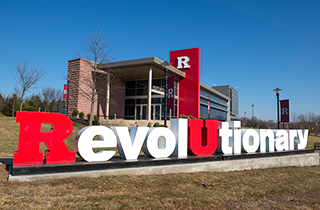 Why is this so important? Accreditation assures students and the public that an institution is educationally sound and financially stable. It is an extremely important indicator of institutional legitimacy. U.S. institutions of higher education must be accredited for their students to be eligible for federal financial aid and for the institution itself to qualify for federal research funding. Accreditation also is valuable for employers to recognize the validity of an institution’s academic programs and whether its graduates have been appropriately prepared for the workforce; for other colleges and universities to accept credits earned at the institution; and for graduates to be admitted to postgraduate study and to sit for licensing examinations.
Why is this so important? Accreditation assures students and the public that an institution is educationally sound and financially stable. It is an extremely important indicator of institutional legitimacy. U.S. institutions of higher education must be accredited for their students to be eligible for federal financial aid and for the institution itself to qualify for federal research funding. Accreditation also is valuable for employers to recognize the validity of an institution’s academic programs and whether its graduates have been appropriately prepared for the workforce; for other colleges and universities to accept credits earned at the institution; and for graduates to be admitted to postgraduate study and to sit for licensing examinations.
We have been preparing for this Middle States accreditation review since mid-2015, and the process has gone smoothly. The Steering Committee, consisting of faculty, students, governing board members, administrators, alumni, and staff from throughout the University, created Working Groups that have drafted chapters for the Self-Study document that we are required to submit to Middle States. The Self Study describes, with links to relevant University policies and other documents, how Rutgers University meets the seven standards of good practice that we are required to meet in order to be reaccredited. The draft Self Study has been circulated to the Steering Committee and will be shared with the Rutgers community in the coming days. We encourage members of the University community to review and comment on the draft. It is important that all Rutgers constituencies have an opportunity to contribute ideas and give feedback on the Self-Study document.
Eric Barron, president of Penn State University, will head the team that travels to Rutgers this coming March to conduct the review. During the visit, the team will travel to our campuses in Newark, New Brunswick, and Camden, as well as to various off-site locations where we offer academic programs.
 Preparation for this reaccreditation visit involves many faculty, staff, and students, and I want to thank them for their good work in getting us ready for the evaluation team visit. As we move through the next two semesters, please keep the team advised, at middlestates2018@rutgers.edu, of any relevant website, document, staffing, policy, or process changes that are made so that the materials submitted to the evaluation team are the most up-to-date. We have much to be proud of at Rutgers, and I look forward to demonstrating that to the visiting evaluation team.
Preparation for this reaccreditation visit involves many faculty, staff, and students, and I want to thank them for their good work in getting us ready for the evaluation team visit. As we move through the next two semesters, please keep the team advised, at middlestates2018@rutgers.edu, of any relevant website, document, staffing, policy, or process changes that are made so that the materials submitted to the evaluation team are the most up-to-date. We have much to be proud of at Rutgers, and I look forward to demonstrating that to the visiting evaluation team.
Concluding Thoughts
As I suggested at the beginning of this report, I believe the coming year will challenge us as individuals and as members of a representative democracy. But we are also a community of scholars who have worked together to create tremendous momentum for Rutgers’ future. In the months ahead, we will have the opportunity to give our students a growing breadth of academic opportunities and an ever-higher level of service, to ensure that our faculty members have the best support for their research, to take New Jersey to a new level of quality in health care, and to make our alumni proud. Let us capitalize on this opportunity and move closer to our highest aspiration—to be counted among the very best public universities in America.